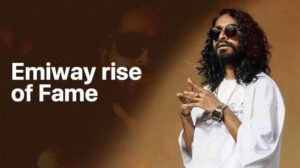Kr$na and Emiway are two of the top artists in India’s hip-hop scene. Over the years, they have built a reputation for their skills as rappers, their unique styles, and their ability to connect with fans.
However, their paths crossed in a diss war that has captured the attention of the music world. In this blog post, we will dive deep into their beef, analyzing each diss track, and discussing who won the battle.
The Start of the Beef

- Emiway started the beef by claiming that he was the only rapper representing India’s beef culture.
- This claim did not sit well with Kr$na, who is known for his love for Indian hip hop and his contributions to the scene.
- The beef began with Emiway’s track “Chusamba,” which was a diss aimed at Kr$na and Raftaar.
- The track received mixed reactions, with many fans criticizing its lack of creativity.
Kr$na’s Response
- Kr$na took his time to respond to Emiway’s “Chusamba,” and when he did, he released “Lil Bunty.”
- The track had a different vibe from his previous tracks, as it was more playful and less intense.
- While it wasn’t as lyrical as some of his other tracks, it was still a solid response to Emiway’s diss.
Emiway’s Clap Back
- Emiway responded with another diss track, which featured hard-hitting clapbacks aimed at Kr$na.
- The track showcased Emiway’s growth as a rapper, and his ability to create meaningful and well-structured tracks.
- Fans of Emiway praised the track, while some fans of Kr$na believed that he had been outmatched.
Emiway Bantai and Kr$na, two powerhouse Indian rappers, are known for their bold style choices. From oversized t-shirts to baggy cargo pants, they effortlessly embody the urban cool aesthetic that ChillMe embraces.
Kr$na’s Next Move
- Kr$na responded to Emiway with “Khauf Hai” , a track that showcased his lyrical prowess.
- The track received mixed reactions from fans, with some believing that it was a solid response, while others believed that it lacked the punch needed to win the beef.
Emiway’s Final Diss
- Emiway’s final diss track, “Machayenge 4,” was a disappointment to many fans.
- While the track showcased Emiway’s ability to create catchy hooks, it lacked the punch of his previous diss tracks.
- Some fans believed that he had played it safe and had not delivered the knockout blow needed to win the beef.
Kr$na’s Victory?
- In the end, Kr$na emerged as the winner of the beef.
- While his response to Emiway’s diss tracks was not always perfect, he managed to hold his own against one of the best rappers in India.
- Emiway’s final track, “Machayenge 4,” was a letdown, and it did not have the impact needed to sway public opinion in his favor.
Lessons Learned
- The Kr$na vs. Emiway beef showcased the importance of diss culture in hip hop, and how it can be used to gain exposure and build a fanbase.
- However, it also highlighted the importance of creativity and originality in diss tracks.
- While both artists showcased their skills, the tracks that stood out were the ones that were well-crafted, and had a unique style and approach.
Diss Culture in Indian Hip-Hop

The beef between Kr$na and Emiway brought to light the diss culture that exists in Indian hip-hop.
- Diss tracks are a common occurrence in the genre, and while they can be seen as a way to showcase one’s lyrical abilities and prove oneself as a top artist, they can also be damaging and counterproductive.
- The focus on beefs and diss tracks takes away from the essence of hip-hop, which is about unity and using music to bring people together.
- It’s important to remember that beefs should be approached with caution and only used when necessary.
Chillme’s Stance

- Both the Baggy Movement and Chillme wish to promote and support the growth of Indian hip-hop artists.
- However, in this situation where two talented artists are dissing each other, all we can do is appreciate their music and spirit for hip hop.
Kr$na’s Impact on Indian Hip-Hop

- Kr$na has successfully built a legacy as one of the top artists in India, as the lyrical god of the hip hop scene, inspiring a new generation of rappers and musicians to explore the genre.
- Kr$na’s dedication to his craft, passion for the culture, and willingness to take risks and innovate have allowed him to create a lasting impact on Indian hip-hop.
- His contributions to the genre have paved the way for other artists and solidified his status as a trailblazer in the industry.
Emiway’s Rise to Fame

- Emiway, on the other hand, has had a meteoric rise to fame in the Indian hip-hop scene.
- Starting out as a YouTube rapper, he quickly gained a following for his unique style and relatable lyrics.
- Emiway’s success is a testament to the power of social media and the ability of artists to use digital platforms to reach a wider audience.
- His rise to fame has also helped to legitimize the Indian hip-hop scene and bring attention to the genre on a global scale.
The Future of Indian Hip-Hop

- The future of Indian hip-hop looks bright, with more and more artists emerging and gaining popularity both in India and abroad.
- The genre has come a long way since its inception, and the success of artists like Kr$na and Emiway has helped to establish it as a legitimate and thriving scene.
- Moving forward, it’s important for artists to continue to push the boundaries of the genre and explore new sounds and styles.
- The focus should be on collaboration and using hip-hop as a tool to bring people together and promote unity.
Conclusion
In conclusion, the beef between Kr$na and Emiway showcased the diss culture that exists in Indian hip-hop, but it also highlighted the potential for the genre to grow and evolve. Both artists have had a significant impact on the Indian hip-hop scene and have helped to solidify its place in the global music landscape.
Moving forward, it’s important for artists to focus on collaboration and using hip-hop as a tool to promote unity and bring people together. With the support of collectives like Artist House and brands like Chillme, the future of Indian hip-hop looks bright and full of potential.
Frequently Asked Questions
A: Kr$na emerged as the winner of the beef due to his ability to hold his own against Emiway and the lackluster impact of Emiway’s final diss track.
A: Diss culture in Indian hip-hop refers to the use of diss tracks as a way to showcase one’s lyrical abilities and prove oneself as a top artist. While it can be seen as a way to gain exposure and build a fan base, it can also be damaging and counterproductive.
A: Both Artist House and Chillme play a crucial role in promoting and supporting the growth of Indian hip-hop. Artist House provides a platform for emerging artists to showcase their talent, while Chillme supports artists through branding and marketing.
A: The future of Indian hip-hop looks bright, with more and more artists emerging and gaining popularity both in India and abroad. The focus should be on collaboration and using hip-hop as a tool to promote unity and bring people together.

